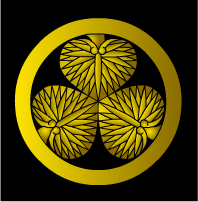
The Tokugawa Go-san-ke (徳川御三家, "the Three Houses of the Tokugawa"), also called simply Go-san-ke (御三家, "the Noble Three Houses"), or even San-ke (三家, "the three houses"), were the most noble three branches of the Tokugawa clan of Japan: Owari, Kii, and Mito, all of which were descended from clan founder Tokugawa Ieyasu's three youngest sons, Yoshinao, Yorinobu, and Yorifusa, and were allowed to provide a shōgun in case of need.[1] In the Edo period the term gosanke could also refer to various other combinations of Tokugawa houses, including (1) the shogunal, Owari and Kii houses and (2) the Owari, Kii, and Suruga houses (all with the court position of dainagon).
Later, Gosanke were deprived of their role to provide a shōgun by three other branches that are closer to the shogunal house: the Gosankyō.
Even after the fall of the Tokugawa shogunate and the abolition of the Edo-period system of administrative domains (han) the three houses continued to exist in some form, as they do into the 21st century.
- ^ Iwanami Nihonshi Jiten, Tokugawa Gosanke, Tokugawa Owari-ke, Tokugawa Kii-ke, and Tokugawa Mito-ke